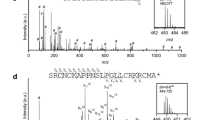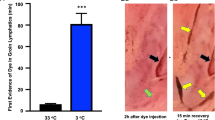Abstract
PREVIOUS workers1 have reported that bee venom contains a hyaluronidase, but the products of its action on hyaluronic acid have not been characterized. In the work recorded here bee venom was obtained from several thousand bees using a novel method of collection. Trays of bees, preferably > 15 days old, were induced to sting into thin sheets (< 0.005 in.) of silicone rubber by subjecting them to a mild electric shock. Under these conditions the bee can withdraw its stinging apparatus and the venom is deposited as a globule on the underside of the sheet where it quickly dries to a crystalline form. The bees themselves appear to become ravenous and will devour large quantities of honey, after which they appear to suffer no adverse effects. In fact, marked bees have been noted working normally on the combs 12 days after venom extraction. The venom crystals (about 0.1 mg/bee) retain their hyaluronidase activity for at least a year if stored at 2°.
This is a preview of subscription content, access via your institution
Access options
Subscribe to this journal
Receive 51 print issues and online access
$199.00 per year
only $3.90 per issue
Buy this article
- Purchase on Springer Link
- Instant access to full article PDF
Prices may be subject to local taxes which are calculated during checkout
Similar content being viewed by others
References
Habermann, E., Neumann, W. P., and Neumann, W., Naturwiss., 43, 84 (1956). Habermann, E., Biochem. Z., 329, 1 (1957).
Weissmann, B., Meyer, K., Sampson, P., and Linker, A., J. Biol. Chem., 208, 417 (1954).
Dische, Z., J. Biol. Chem., 167, 189 (1947).
Morgan, W. T. J., and Elson, L. A., Biochem. J., 28, 988 (1934).
Jeanloz, R. W., and Forchielli, E., J. Biol. Chem., 188, 361 (1951).
Linker, A., Meyer, K., and Hoffman, P., J. Biol. Chem., 219, 13 (1956).
Bellamy, L. J., The Infra-red Spectra of Complex Molecules, 31 (Methuen and Co., Ltd., 1954).
Rondle, C. J. M., and Morgan, W. T. J., Biochem. J., 61, 586 (1955).
Wolstenholme, G. E. W., and O'Connor, M., Ciba Foundation Symp., Chem. and Biol. Mucopolvsaccharides, 64 (J. and A. Churchill, Ltd., 1958).
Author information
Authors and Affiliations
Rights and permissions
About this article
Cite this article
BARKER, S., BAYYUK, S., BRIMACOMBE, J. et al. Characterization of the Products of the Action of Bee Venom Hyaluronidase. Nature 199, 693–694 (1963). https://doi.org/10.1038/199693a0
Issue Date:
DOI: https://doi.org/10.1038/199693a0
This article is cited by
Comments
By submitting a comment you agree to abide by our Terms and Community Guidelines. If you find something abusive or that does not comply with our terms or guidelines please flag it as inappropriate.



